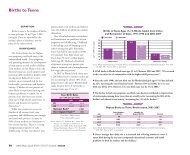2010 Rhode Island Kids Count Factbook
2010 Rhode Island Kids Count Factbook
2010 Rhode Island Kids Count Factbook
Create successful ePaper yourself
Turn your PDF publications into a flip-book with our unique Google optimized e-Paper software.
Infant and Preschool Child Care<br />
DEFINITION<br />
Infant and preschool child care is the<br />
number of regulated child care slots per<br />
100 children under age six estimated to<br />
be in need of care. Regulated child care<br />
slots include licensed child care center<br />
slots and licensed family child care<br />
home slots.<br />
SIGNIFICANCE<br />
Child care enables parents to work<br />
and, when high quality, supports the<br />
development of important schoolreadiness<br />
skills. Research indicates<br />
that high-quality child care and earlylearning<br />
programs for infants, toddlers<br />
and preschoolers have long-lasting<br />
positive effects on how children learn,<br />
develop, cope with stress, and handle<br />
their emotions. 1<br />
Early and extensive enrollment in<br />
child care is common in the United<br />
States and is a basic need for many<br />
working families in <strong>Rhode</strong> <strong>Island</strong>.<br />
Between 2006 and 2008, an estimated<br />
68% of <strong>Rhode</strong> <strong>Island</strong> children under<br />
age six had all parents in the workforce,<br />
higher than the U.S. estimated rate of<br />
63%. 2 National data indicate that, on<br />
average, preschoolers with an employed<br />
mother spend 28 hours per week in<br />
non-parental care, compared to 18<br />
hours per week for children with<br />
mothers not in the workforce. 3<br />
The availability of stable child care<br />
is critical for <strong>Rhode</strong> <strong>Island</strong>’s economy.<br />
When parents have difficulty finding<br />
and keeping child care, they miss work<br />
more frequently and are more likely to<br />
leave their jobs. 4 Access to affordable,<br />
quality child care plays a pivotal role in<br />
supporting maternal employment and<br />
economic self-sufficiency. On average,<br />
women with children earn lower hourly<br />
wages than women without children. In<br />
contrast, having children has a positive<br />
or no impact on men’s wages. Research<br />
shows that greater use of child care<br />
during the early childhood years is<br />
associated with higher hourly wages for<br />
mothers and more hours of maternal<br />
employment in the long term,<br />
indicating that child care support can<br />
improve women’s career trajectories. 5<br />
In 1997, <strong>Rhode</strong> <strong>Island</strong> passed<br />
legislation known as Starting Right to<br />
improve low-income families’ access to<br />
affordable quality child care. With the<br />
passage of Starting Right, <strong>Rhode</strong> <strong>Island</strong><br />
experienced significant growth in the<br />
availability of regulated child care.<br />
<strong>Rhode</strong> <strong>Island</strong> families receiving child<br />
care subsidies are significantly more<br />
likely to choose licensed and certified<br />
care rather than non-certified care. 6<br />
Researchers have found that<br />
unregulated child care is often of low<br />
quality. 7 When the availability of child<br />
care is sufficient to meet demand and<br />
child care subsidies are accessible and<br />
tied to market rates, families have more<br />
options and can make enrollment<br />
decisions based on the quality of the care.<br />
01400<br />
01300<br />
01200<br />
110 00<br />
1000<br />
9000<br />
8000<br />
7000<br />
6000<br />
5000<br />
4000<br />
3000<br />
2000<br />
Infant and Preschool Child Care Capacity, <strong>Rhode</strong> <strong>Island</strong>, 1999 - 2009<br />
14,000<br />
13,000<br />
12,000<br />
11,000<br />
10,000<br />
9,000<br />
8,000<br />
7,000<br />
6,000<br />
5,000<br />
4,000<br />
3,000<br />
2,000<br />
Center Child Care Slots Under Age 3<br />
Center Child Care Slots Age 3 to 5<br />
Family Child Care Slots Age Birth to 12<br />
10,942<br />
5,295<br />
4,164<br />
1999 2000 2001 2002 2003 2004 2005 2006 2007<br />
Source: Options for Working Parents, slots in licensed child care centers and certified family child care homes 1999-2006.<br />
<strong>Rhode</strong> <strong>Island</strong> Department of Children, Youth and Families, slots in licensed child care centers and certified family<br />
child care homes, 2007-2009.<br />
◆ In 2009 in <strong>Rhode</strong> <strong>Island</strong>, there were 22,283 slots for children under age six in licensed<br />
child care centers and certified family child care homes, down from a peak high of<br />
26,243 in 2006, but up from 20,383 in 1999. 8<br />
◆ Since 1999, the number of licensed child care center slots for infants and toddlers<br />
(children under age three) in <strong>Rhode</strong> <strong>Island</strong> has increased fairly steadily, growing 35%,<br />
from 4,164 to 5,605 in 2009. 9<br />
◆ The number of licensed child care center slots for preschoolers (children ages three to<br />
five) has grown more slowly than slots for infants and toddlers since 1999. Between 1999<br />
and 2009, there has been a 10% increase in the number of licensed slots for<br />
preschoolers. 10<br />
◆ The number of licensed family child care slots grew 62% between 1999 and 2006.<br />
Since 2006, the number of family child care slots has decreased; the 2009 level is 12%<br />
below the capacity in 1999. 11<br />
2008<br />
12,009<br />
5,605<br />
4,669<br />
2009<br />
118 <strong>2010</strong> <strong>Rhode</strong> <strong>Island</strong> KIDS COUNT <strong>Factbook</strong> / Education






